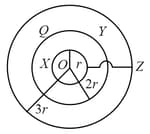MEDIUM
Earn 100
Explain why a charged balloon is repelled by another charged balloon whereas an uncharged balloon is attracted by a charged balloon.
Important Questions on Electricity and Magnetism
EASY
MEDIUM
EASY
EASY
MEDIUM
EASY
MEDIUM
MEDIUM
Describe an activity to show that opposite charges attract.
MEDIUM
EASY
MEDIUM
EASY
EASY
EASY
MEDIUM
MEDIUM
EASY
Reason: In case of sharing of charges conservation of energy fails.
EASY
EASY
HARD


